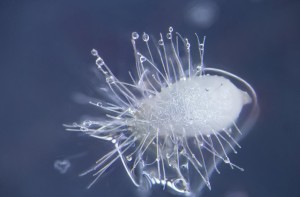Are European orchids threatened by anorganic nitrogen -one of the main drivers of global change?
fig.1 oligotrophic canopy of P.albida, in albania distr. Tropoje
fig.2 oligotrophic canopy of P.albida with local sheppard in Albania, Tropoje, 2nd Photo by Jaroslav Vojta
A quarter of species of the second world biggest plant family – Orchidaceae is at risk of extinction. This could be caused due to smuggling, habitat loss and impact of climate change (1). Orchids have specific physiology, and many researchers have been studying them in last decades either due to their commercial production, their loss from nature or their specific biology. One of their specific trait is that they have minute seeds, almost without nutrients, and they germinate only under specific conditions. Many species are cultivated for commercial or research purposes but some species have never been germinated in conditions in vitro (or in situ), and we do not know why they are not growing. This was the case of Pseudorchis albida, which is and not just according to our study (2), extremely strongly inhibited by inorganic nitrogen. P.albida will not grow when there is even very low concentration of inorganic nitrogen in substrate (2 mg of No3 per liter of growing media).
In Europe, concentrations of anorganic nitrate in soil are between 0.1 – 100 mg/l NO3 (3, 4, 5), and globally N levels are rising. When we look at hygienic limit for concentration of nitrates in tap water in EU, it is 50 mg/l, and this concentration is sometimes reached, or even exceeded. The real data shows e.g. 37,6 and 19,2 mg per liter for Prague (6). But when we look into other sources (7) we can see that the concentration of nitrates in most European water sources is already above 100 mg/l. According to this we can conclude that this species will not grow when watered with tap water from almost all European water sources, because just concentration of 50 mg/l of nitrates inhibits germination 44 times and when sowed on concentration 100 mg/l this species is not growing at all ! (2)
This specific inhibition on seed germination and subsequent growth is not specific just for Pseudorchis albida, but we found similar extremely strong inhibition also on many other orchid species, which are evolutionary or ecologically common to Pseudorchis albida and also some effect on species Orthilia secunda, which belongs to Ericaceae family (yet unpublished data).
We can just speculate why those plants have this inhibition or where is the evolutionary purpose of this inhibitory effect; it could be some mechanism which is protecting the seed from germinating on places which are rich on inorganic nitrogen, and therefore place like this could be easily inhabited by expansive or/and ruderal species, and subsequently that place would not be suitable for growing of an orchid. However it is obvious that many orchid species are disappearing from nature and it looks like that some of them probably just due to the nitrogen – one of the main drivers of global change.
Important information which we should keep in our minds is that because of increased use of fertilizers, there is very steep increase of nitrogen levels in nature in last years (f.e. 8) and one of bad consequences of this could be potential loss of some orchids from nature. This can happen really quickly and even before we find out how to save those species at least using in vitro/in situ cultivation.
fig.3.: mycoheterotrophic protocorm of P. albida
1 Swarts, N.D., Dixon, K.W.: Terrestrial orchid conservation in the age of extinction. – Ann. Bot. 104: 543-556, 2009.
2 Ponert, J., Figura, T., Vosolsobe, S., Lipavska, H., Vohnik, M., & Jersakova, J. (2013). Asymbiotic germination of mature seeds and protocorm development of Pseudorchis albida (Orchidaceae) are inhibited by nitrates even at extremely low concentrations. Botany
3 Callesen, I., Raulund-Rasmussen, K., Gundersen, P., and Stryhn, H. 1999. Nitrate
concentrations in soil solutions below Danish forests. For. Ecol. Manage.
114(1): 71–82.
4 Fetter, J.C., Brown, R.N., Görres, J.H., Lee, C., and Amador, J.A. 2012. Nitrate and
phosphate leaching under turfgrass fertilized with a squid-based organic
fertilizer. Water Air Soil Pollut. 223(4)
5 Pedersen, A., Petersen, B.M., Eriksen, J., Hansen, S., and Jensen, L.S. 2007. A
model simulation analysis of soil nitrate concentrations — Does soil organic
matter pool structure or catch crop growth parameters matter most? Ecol.
Modell. 205(1-2)
6 http://www.pvk.cz/res/data/001/000205.pdf?seek=2
7 Commision of the europaean communities (2007):Comission staff working
dokument: Accompanying document to the Report to the commission to the council and the europaean parliament on implementation of Council Directive 91/676/EEC concerning the protection of waters against pollution caused by nitrates from agricultural sources for the period 2000-2003 COM (2007) 120 final
8 Tilman, D., Fargione, J., Wolff, B., D’Antonio, C., Dobson, A., Howarth, R., … & Swackhamer, D. (2001). Forecasting agriculturally driven global environmental change. Science, 292(5515), 281-284.
Tomáš Figura


